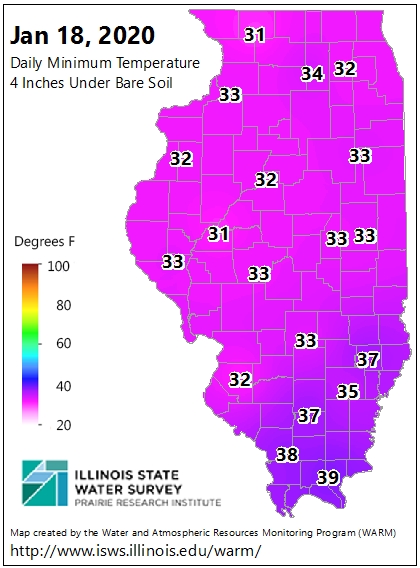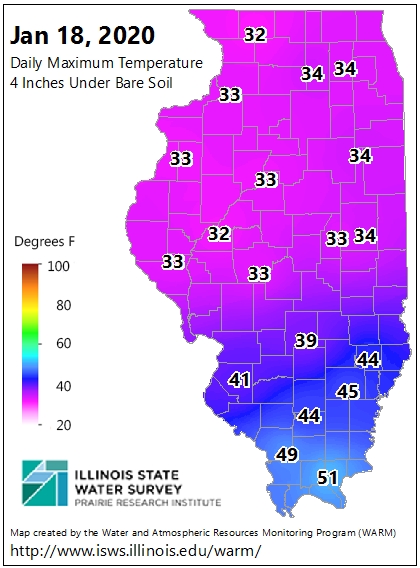Despite the recent cold, Illinois has had a warm winter so far with air temperatures averaging 7.3° F above normal as of Jan. 18. This weather has led to warmer and wetter soils across the state.
Statewide, soil temperatures at depths of 4 inches under bare soil averaged 38.0° between Dec. 1 and Jan. 18, 1.3° warmer than last winter and 3.0° higher than the long-term average. These numbers were greatly influenced by the balmier weather at the end of December when soil temperatures were 10–15° above normal with daily highs in the upper 50s.
 The state did see cooler soils in mid-December as temperatures fell to the low 30s or 2–4° lower than normal with daily highs in the mid-20s. However, for most of this winter so far, soils for most of the state have remained above freezing.
The state did see cooler soils in mid-December as temperatures fell to the low 30s or 2–4° lower than normal with daily highs in the mid-20s. However, for most of this winter so far, soils for most of the state have remained above freezing.
Monitoring locations in northern Illinois have seen periods of frozen soils. At Freeport in Stephenson County, the average bare temperatures were below freezing from Dec. 11 to the 24 before rising to the 40s at the end of the month. Temperatures have continued to hover in the low 30s for most of January.
The south has experienced warmer soils throughout this winter. At the Dixon Spring monitoring station in Pope County, soils have remained above freezing throughout the winter as lows fell only into the mid-30s. On average, southern Illinois soils have been 6° warmer this season than those in the north.
 Under sod, soils have been slightly warmer with a seasonal average of 39.7° as of Jan. 18, 1.1° higher than last year and 3.4° warmer than normal. Temperatures have remained above freezing at most monitoring stations.
Under sod, soils have been slightly warmer with a seasonal average of 39.7° as of Jan. 18, 1.1° higher than last year and 3.4° warmer than normal. Temperatures have remained above freezing at most monitoring stations.
This winter has also been wetter than usual. The state received 5.73 inches of precipitation between Dec. 1 and Jan. 18, 1.96 inches more than usual for this period of the year. The wetter weather and warmer, non-frozen soils have caused soil moisture to increase at monitoring stations across Illinois.
Soil moisture at 2-inch depths averaged 0.45 water fraction by volume (wfv) in mid-January, levels that are above the field capacity for most of the soils monitored. In east central and southern Illinois, soils were even wetter with regional averages of 0.50 and 0.52 wfv, respectively.
Higher soil moisture levels were present at depths from 2 inches to 5 feet. At present, the levels are similar to those seen last winter.
Illinois Climate Network
The soil temperature and moisture data have been collected through the Illinois State Water Survey’s Illinois Climate Network (ICN). In operation for more than 30 years, ICN monitors the Illinois’ weather and soils at 19 stations. Hourly, daily and long-term data are available at https://www.isws.illinois.edu/warm/. Access is free but registration is required.




 and then
and then